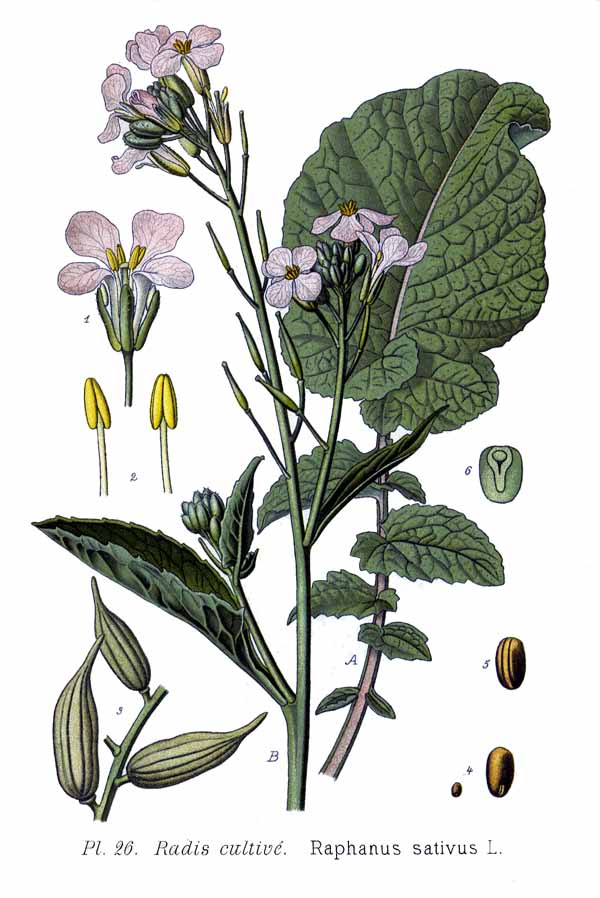Dies ist eine alte Version des Dokuments!
Raphanus sativus L. - Brassicaceae - radish, Garten-Rettich, Ölrettich
Annual or bienniel herb, up to 1m high, only known in culture; flowers violet or white; fruit a berry.
„Varieties of radish are now broadly distributed around the world, but there are almost no archeological records available to help determine its early history and domestication. However, scientists tentatively locate the origin of Raphanus sativus in southeast Asia, as this is the only region where truly wild forms have been discovered… The most commonly eaten portion is the napiform taproot, although the entire plant is edible and the tops can be used as a leaf vegetable. The seed can also be sprouted and eaten raw in a similar way to a mung bean.“
http://en.wikipedia.org/wiki/Radish
Some cultivated subspecies/varieties are known:
Raphanus sativus subsp. sativus L. - small radish, Radieschen
Raphanus sativus convar. sativus Radish Group - radish, (Winter-) Rettich
Raphanus sativus var. black - black radish, Schwarzer Rettich
Raphanus sativus var. longipinnatus - 大根 (jap.), 白蘿蔔 (chin.), daikon, Daikon
Raphanus sativus L. var. oleiformis Pers. - oil radish, Ölrettich
Raphanus sativus L. var. mougri H. W. J. Helm - serpent radish, Schlangenrettich
„White Radish, or daikon (Raphanus sativus) is a popular root vegetable in East Asian countries… The Japanese processing white radish cultivar, Hoshiriso, was grown in spring, summer, autumn and winter on the Central Coast of New South Wales, Australia and accumulation of the characteristic pungent flavour component, 4-methylthio-3-trans butenyl isothiocyanate (MTBITC) during growth was determined. MTBITC concentration was found to be higher in roots grown in autumn and spring than in winter and summer.“
[Pungency levels of white radish (Raphanus sativus L.) grown in different seasons in Australia., Coogan, R.C., Wills, R.B.H., Nguyen, V.Q., Food chemistry, 72(1), 2001, 1-3]
„Raphanus sativus contained sulforaphene, plus sulforaphane, glucodehydroerucin, and gluconapin.“
[Glucosinolates of seven medicinal plants from Thailand., Songsak, T., Lockwood, G.B., Fitoterapia, 73(3), 2002, 209-216]
Sulforaphene constituted a major isothiocyanate in radish.
[Analysis of isothiocyanates in newly generated vegetables, Baemuchae (× Brassicoraphanus) as affected by growth., Lim, S., Lee, J., Kim, J.K., International journal of food science & technology, 44(7), 2009, 1401-1407]
„The volatile constituents from the leaves and roots of Raphanus sativus var. black, white and red were isolated by hydrodistillation in a Clevenger-type apparatus and were analysed by gas chromatography and gas chromatography–mass spectrometry. The major components found in the oil of all leaves were phytol (65.3–69.7%), hexadecanoic acid (2.5–14.3%), methyl linolenate (2.1–11.1%) and (Z)-3-hexen-1-ol (0.7–6.9%). Corresponding aliphatic or aromatic glucosinolate compounds identified in the leaves constituted only 0.3–5.7% of the isolated volatiles. They were 5-(methylthio)-4-pentenenitrile (0.3–2.2%), 4-(methylthio)butyl isothiocyanate (0.3–1.7%), 2-phenylethyl isothiocyanate (0.4%), 4-(methylthio)-3-butenyl isothiocyanate, 4-methylpentyl isothiocyanate, benzyl isothiocyanate and benzenepropanenitrile. The major components in the oil of all roots were hexadecanoic acid (30.3–49.9%), 4-(methylthio)butyl isothiocyanate (17.9–25.7%), methyl linolenate (8.5–21.7%), 5-(methylthio)-4-pentenenitrile (1.5–6.9%), dimethyl trisulfide (1.1–3.8%), 5-(methylthio)pentyl isothiocyanate (0.5–2.0%), 4-(methylthio)-3-butenyl isothiocyanate (0.2–1.8%) and 2-phenylethyl isothiocyanate (0.1–1.5%).“
[Glucosinolate degradation products and other bound and free volatiles in the leaves and roots of radish (Raphanus sativus L.)., Blažević, I., Mastelić, J., Food Chemistry, Vol.113(1), 2009, 96-102]

see also http://commons.wikimedia.org/wiki/Category:Raphanus_sativus

